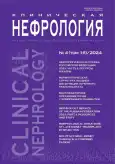Difficulties in the differential diagnosis of comorbid fluid and electrolyte balance disorders: description of a clinical case
- Authors: Pivovarov D.V.1, Mikhailova Z.D.1
-
Affiliations:
- Municipal Clinical Hospital No.38
- Issue: Vol 16, No 4 (2024)
- Pages: 48-52
- Section: Clinical case
- Published: 08.12.2024
- URL: https://journals.eco-vector.com/2075-3594/article/view/679987
- DOI: https://doi.org/10.18565/nephrology.2024.4.48-52
- ID: 679987
Cite item
Abstract
Background. One of the disorders reflecting the pathology of water-electrolyte balance is polyuria-polydipsia syndrome. The most well-known forms of this syndrome include central and nephrogenic diabetes insipidus and primary polydipsia. Accurate verification of the diagnosis in patients with polyuria-polydipsia syndrome is a complex and labor-intensive process. A particular problem for clinicians is the combination of various forms of this syndrome, as well as its combination with electrolyte imbalance, including hyponatremia. One of the little-known causes of hyponatremia is reset osmostat syndrome. The article describes a clinical case of a possible combination of nephrogenic diabetes insipidus with primary polydipsia in a patient, while the presence of reset osmostat syndrome was not excluded.
Full Text
About the authors
Dmitry V. Pivovarov
Municipal Clinical Hospital No.38
Author for correspondence.
Email: pivovarov121094@yandex.ru
ORCID iD: 0000-0002-6642-1364
Cand.Sci. (Med.), Physician
Russian Federation, Nizhny Novgorod, Chernyshevsky str., 22Zinaida D. Mikhailova
Municipal Clinical Hospital No.38
Email: zinaida.mihailowa@yandex.ru
ORCID iD: 0000-0002-0926-6038
Dr.Sci. (Med.), Assoc. Prof., Consulting Physician
Russian Federation, Nizhny Novgorod, Chernyshevsky str., 22References
- Hui C., Khan M., Khan Suheb M.Z., et al. Arginine Vasopressin Disorder (Diabetes Insipidus). 2024 [Electronic resource]. URL: https://www.ncbi.nlm.nih.gov/books/NBK470458 (data of the application: 10.10.2024).
- Вагапова Г.Р. Вопросы дифференциальной диагностики и лечения центрального несахарного диабета. Мед. совет. 2018;(4):74–80. [Vagapova G.R. Issues of differential diagnosis and treatment of central diabetes insipidus. Med. Adv. 2018;(4):74–80. (In Russ.)]. doi: 10.21518/2079-701X-2018-4-74-80.
- Mutter C.M., Smith T., Menze O., et al. Diabetes insipidus: pathogenesis, diagnosis, and clinical management. Cureus. 2021;13(2):e13523. doi: 10.7759/cureus.13523.
- Лукьянчиков В.С. Несахарный диабет и коморбидные нарушения водно-электролитного обмена. Мед. совет. 2017;(3):89–94. [Luk'yanchikov V.S. Diabetes insipidus and comorbid disorders of water and electrolyte metabolism. Med. Adv. 2017;(3):89–94. (In Russ.)]. doi: 10.21518/2079-701X-2017-3-89-94.
- Дедов И.И., Мельниченко Г.А., Пигарова Е.А. и др. Федеральные клинические рекомендации по диагностике и лечению несахарного диабета у взрослых. Ожирение и метаболизм. 2018;15(2):56–71s. [Dedov I.I., Mel'nichenko G.A., Pigarova E.A., et al. Federal clinical guidelines for the diagnosis and treatment of diabetes insipidus in adults. Obes. Metab. 2018;15(2):56–71s. (In Russ.)]. doi: 10.14341/OMET9670.
- Christ-Crain M. EJE AWARD 2019: New diagnostic approaches for patients with polyuria polydipsia syndrome. Eur. J. Endocrinol. 2019;181(1):R11–21. doi: 10.1530/EJE-19-0163.
- Гусейнова Р.М., Пигарова Е.А., Дзеранова Л.К. Ремиссия нефрогенного несахарного диабета (резистентность к антидиуретическому гормону): описание редкого клинического случая. Ожирение и метаболизм. 2024;21(1):92–8. [Gusejnova R.M., Pigarova E.A., Dzeranova L.K. Remission of nephrogenic diabetes insipidus (antidiuretic hormone resistance): description of a rare clinical case. Obes. Metab. 2024;21(1):92–8. (In Russ.)]. doi: 10.14341/omet13007.
- Казангапов Э.Б., Бельчикова Л.Н. Диагностика психогенной полидипсии на примере клинического случая. Проблемы эндокринологии. 2024;70(2):65–9. [Kazangapov E.B., Bel'chikova L.N. Diagnosis of psychogenic polydipsia based on a clinical case. Probl. Endocrinol. 2024;70(2):65–9. (In Russ.)]. doi: 10.14341/probl13359.
- Kotagiri R., Kutti Sridharan G. Primary Polydipsia. 2024 [Electronic resource]. URL: https://www.ncbi.nlm.nih.gov/books/NBK562251 (data of the application: 10.10.2024).
- Rondon H., Badireddy M. Hyponatremia. 2024 [Electronic resource]. URL: https://www.ncbi.nlm.nih.gov/books/NBK470386 (data of the application: 10.10.2024).
- Астафьева Л.И., Бадмаева И.Н., Клочкова И.С. и др. Синдром переустановки осмостата – когда гипонатриемия становится «нормой»: аспекты диагностики, описание клинического случая. Проблемы эндокринологии. 2023;69(5):65–72. [Astaf'eva L.I., Badmaeva I.N., Klochkova I.S., et al. Reset osmostat syndrome – when hyponatremia become «a normal»: diagnostics, case report. Probl. Endocrinol. 2023;69(5):65–72. (In Russ.)]. doi: 10.14341/probl13235.
- Feder J., Gomez J.M., Serra-Aguirre F., Musso C.G. Reset Osmostat: Facts and Controversies. Indian J. Nephrol. 2019;29(4):232–4. doi: 10.4103/ijn.IJN_307_17.
Supplementary files








